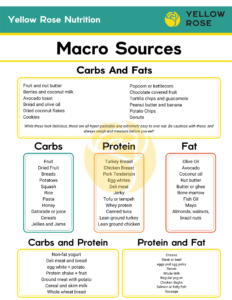by Clark Hibbs
This is part 3 of 3 in a blog series in which we’ll be discussing each of the main macronutrients. These macronutrients are carbohydrates, proteins, and fats.
Today, we are taking the deep dive into the world of FAT. If you haven’t read the previous posts in this series about the basics of nutrition, performance nutrition, carbohydrates, or protein, do that before you read this!
At this point, we’ve talked pretty extensively about carbs and protein, but we haven’t chatted about fat. What role does it play? How should I manage it with weight loss? Why should I go with leaner food options?
Let’s dive in.
First, the most important question: what role does dietary fat play in our daily nutrition?
Fats are absolutely essential to our health and to our survival. You absolutely need to consume fats in order to live. They are vital for cellular health, hormonal health and regulation, brain function, and are also a source of energy.
While many of us thrive on our morning coffee for energy, our fats and fat storages are the energy source we depend on mostly throughout the day in a non-exercise environment. Your body uses the fat in your fat cells to fuel the necessary internal processes to keep you alive. Our body will use glycogen and carbohydrates to fuel our workouts and other highly strenuous activities, but the everyday stuff? That’s all fat!
Fat is good. Fat is important. Fat is necessary for a healthy body (which is why I will, more often than not, encourage people to not worry so much about getting ridiculously lean).
Fat with Weight Loss
When it comes to losing weight, we know from our Basics of Nutrition post that we need to establish a calorie deficit and maintain that consistently in order to see results. While there are a myriad of ways to actually create the calorie deficit, one of the easiest ways is by reducing our overall fat intake.
Why? Well…
1 gram of protein – 4 calories
1 gram of carbohydrates – 4 calories
1 gram of fat – 9 calories
Yes, fat literally has more than double the calories of a single gram of protein of carbohydrates.
“But wait, didn’t you just say fat is good for you? This makes it look like it’s bad for you!”
Oh no, no, no. Far from that. Let’s also dismiss the narrative that just because something has less calories means that it’s healthier. Sometimes MORE calories is actually a healthier option depending on that person’s unique situation.
Anyway, back to reducing fat intake.
From our experience, we know that the macronutrient that is constantly over eaten is fat. Why?
FATS ARE DELICIOUS.
And not just single fat sources like olive oil or butter, but specifically foods that have the majority of their calories coming from fat!
Butter? Amazing.
Steak? Yes please. Also baste that sucker in garlic butter.
Cookies? Hell yeah. It’s a magical carb/fat concoction for the gods.
Peanut butter? HELLLLLL YEAH. It’s actually my favorite source of fat!
And the REAL problem with all of the foods that are just oh-so-delicious? They’re extraordinarily palatable. We like to use the term hyper-palatable for these foods. Donuts. Cakes. Ice cream. Oreos. All of these hyper-palatable foods are extremely high in fat, and extremely easy to overeat. If we can limit these hyper-palatable foods from our daily diet, we can very easily bring down our fat intake, which will in turn bring our overall calories well down.
How much fat should I be eating?
Fat is a highly nuanced situation based on your genetic predisposition for heart disease and other pre-existing conditions. The following advice is directed at those without any genetic risk or conditions.
As a blanket statement and general recommendation, we like the range of .25 – .5g of fat per pound of bodyweight. I weighed 211 pounds this morning, so my maintenance level fat intake would be around 53 – 105g each day.
Sheesh. That’s a pretty big range.
Yes, yes it is. That is of course a general range to make sure I’m eating enough of my necessary fats so I can be a high functioning individual, but also putting the lid on fat intake to make sure I’m not going overboard. However, when paired with my other macronutrients in alignment with my calorie intake goals, we’re able to hone in that range much easier.
For most people, a general macronutrient split of 40% carbs, 30% protein, and 30% fat is a really solid and sustainable way of managing your intake. Assuming I use the formula of bodyweight x 13 to find my estimated BMR, that would put my calories at ~2,700.
By then utilizing our 40/30/30 split, my macros would then look like this:
Protein – 202g
Carbs – 270g
Fat – 90g
Bingo. Right in the range! For a calorie deficit, we would simply subtract 250-400 calories from the 2700 and make the macronutrient adjustments from there. As long as the fats fall into the .25 – .5g range, that fat intake is good to go!
A Quick Note on the 40/30/30
This is a very general ratio that works well for many, many people. However, some people might find 40% carbohydrates too filling. In that situation we could always do 30/35/35, or 30/40/30, or whatever combination helps yield the best results for the desired outcome!
Managing Fat Intake – Lean vs Fatty Foods
In our carb post, I used the example of broccoli vs skittles in the sense of hyper palatability. It would take you 2.5 bags of steamed broccoli in order to reach the same amount of calories as a normal bag of skittles.
With our fat intake, we want to take the same sort of approach and find options that are going to be lower in fat, and higher in overall volume.
Take a 6oz grilled chicken breast versus a 6oz grilled steak.
6oz Chicken breast
6g fat
53g protein
Total Calorie – 283
6oz Steak (USDA Ribeye)
39g fat
36g protein
Total Calorie – 493
Oh dear.
While we love the 36 grams of protein from that steak, just look at that fat allotment! For someone like myself who would have a high fat allotment each day, that is still almost 50% of my daily fat from 6oz of steak. For smaller folks, that could be well above 50% and could make the rest of the day decently tricky.
We think it’s a solid idea to build the habit of lean meats as a solid protein source for your daily intake. Chicken, turkey, venison, or other options where the majority of the calorie intake comes from protein, not fat. Check out this graphic! This is just the tip of the iceberg when it comes to food options, but hopefully this will help!
Omega-3 Fatty Acids
I’m sure by now in your life you’ve heard of “good fats” and “bad fats.” We Americans tend to get plenty of the bad ones without much effort at all, but we tend to undershoot the good fats. One of those exceedingly good fats is the Omega-3 Fatty Acids.
Omega-3 fatty acids are a polyunsaturated fat that can often come from plant sources, but are by and large most commonly found in fish. These fatty acids act as anti-inflammatories in the body, and have been linked to helping individuals lower their blood pressure. The American Heart Association recommends that individuals should eat 3-4 ounces of fish at least twice a week to get a good amount of omega-3s. However, if fish isn’t your thing, you can always take an omega-3 fish oil supplement.
—————
The world of dietary fat can be an extremely confusing one. One day fats are bad. One day fats are good. One day your neighbor is only eating chicken breast, and the next they’re putting butter in their coffee (don’t do this).
The things we know for the vast majority of the population: fats are a necessary part of your diet, but they can be a very slippery slope towards a calorie surplus. Find your recommended fat intake range, and do your best to stick with that for your optimum health.
That’s the end of this blog. Next week we will discuss how to track your macros effectively.
If you want to really learn about what works best for you and get the results you want, I highly recommend reaching out to Coach Rachel Hibbs ([email protected]) to learn more about our personalized nutrition program we offer here at Yellow Rose.
Thanks for reading along! If there’s another series you’d like me to dive into, please send me an email [email protected] with your ideas.
-Clark





